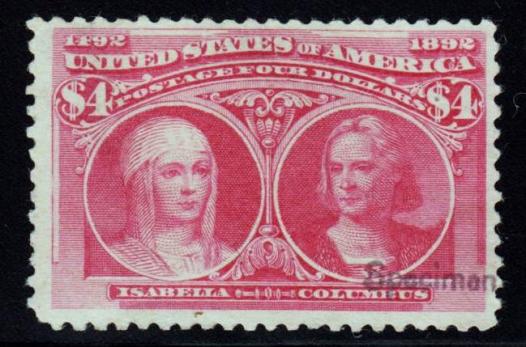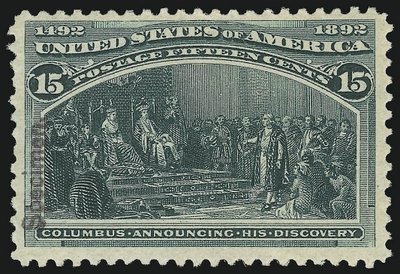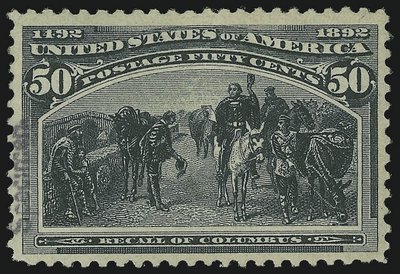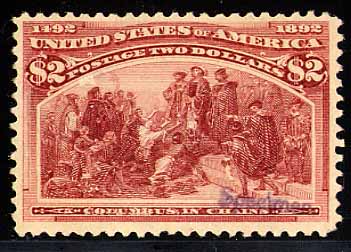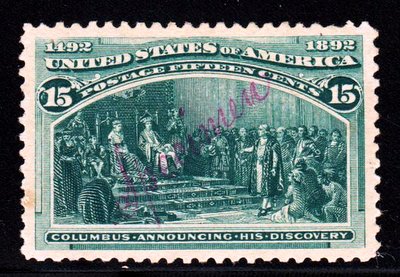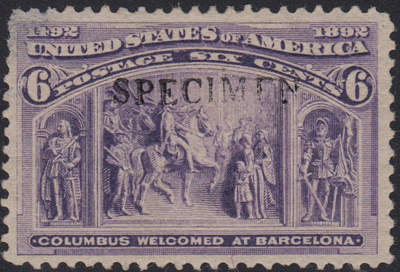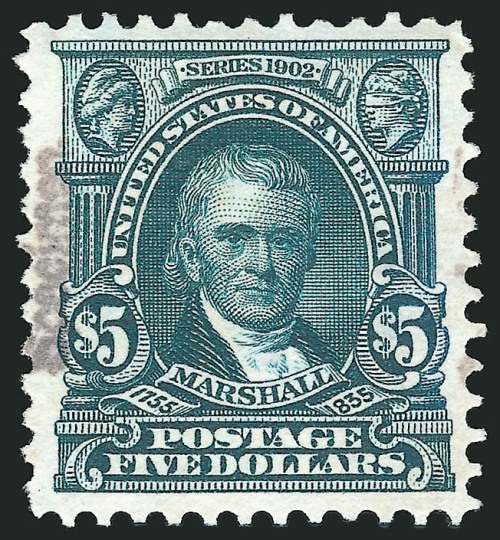
Edwin Madden, the 3rd Assistant Postmaster General (1899-1907) occupies a singular place in American philatelic history due to his involvement with the release of the inverted 4 cent value of the 1901 Pan-American Exposition issue. James H. Bruns’ 1990 article, “Edwin C. Madden’s Influence on U.S. Philately” (American Philatelic Congress 1991) is the definitive discussion of the production and distribution of the 4 cent invert, examples of which Mr. Madden handed out to friends, colleagues — but, mainly, to political benefactors and elected officials — between the years 1901 through 1904. The resulting scandal likely ended Madden’s practice of distributing other “specimen” overprints, which (while less valuable) doubtless followed the same practice of political cronyism reflected in the 4c invert scandal.

304S-E, the five cent blue with plate number 1537, with Madden’s handstamp (Type E) in purple.
Madden hailed from Detroit, where he worked as a fireman, and later an engineer, on the Detroit, Grand Haven and Milwaukee Railroad. A member of the Brotherhood of Locomotive Engineers, that affiliation may have both given him a taste for, and an entry into, politics. It certainly greased the skids for his entry into the world of the Post Office, thanks to his benefactor, Russell Alger, then governor of Michigan. A slight variation on other stories guided by another Alger, but nonetheless Madden was seen by his colleagues and employees as a rags to riches story, as reflected in the title of an article in April 1900 issue of a periodical called The Fourth Class Postmaster, “Perseverance and Pluck Combined with Native Ability Have Brought Mr. Madden From Messenger Boy to His High Position.” Indeed, Madden made significant postal improvements, including the system of letter carrier registration, hence saving the patron a trip to the local post office to register items.
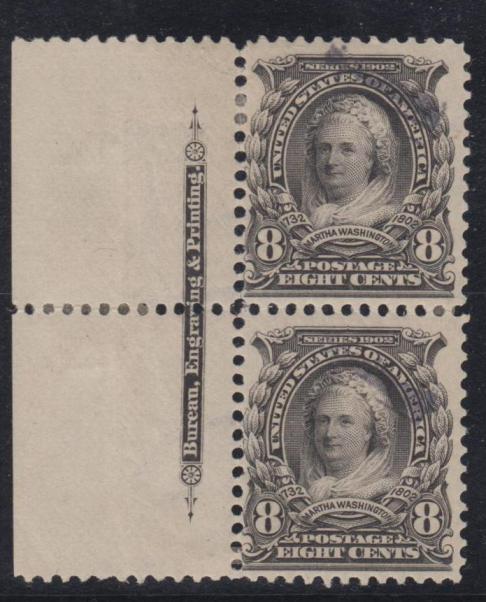
(306S-E), the 8c violet black, imprint pair.
This conscientious and capable postal official nonetheless shouldered responsibility for several embarrassing mistakes, chief among them the distribution of the “specimen” overprinted 4c Pan-American invert. Madden’s first line of defense was to claim that what he did was modest by comparison to what his predecessors did. To this end, he furnished a chart of the give-aways distributed during his and earlier postal administration, underscoring two critical points. First, that the use of “give aways” (with or without specimen overprints) was a time-honored political tradition; second, that Madden was able to access his own lists of beneficiaries of this largesse, as well as lists compiled by his predecessors.
We have the Madden four cent invert “gift list”. It reveals three especially interesting facts. First, the number of specimen inverts distributed: 186. Second, the recipients, including (primarily Republican) politicos, such as Massachusetts Senator Henry Cabot Lodge, two future Vice-Presidents, Attorney General Philander C. Knox, and George Cortelyou, then secretary to President Roosevelt, and later the first Secretary of the Department of Labor and Commerce. Third, that Madden kept meticulous records, which reflected the fact that he continued to distribute these specimens well after the initial scandal over the production of the error first broke, in 1901.
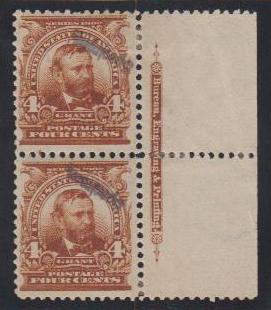
(303S-E), the 4c brown, Type E specimen, imprint pair
One less well-known recipient of the invert was Rep. Edgar Weeks, a Michigan congressman who obtained his 4c Pan-American from Mr. Madden on February 15, 1902. Weeks was finishing his second (and last) term in Congress. Other members of the Michigan Republican congressional delegation also received these stamps.
One year after bestowing upon Weeks his 4c invert, Mr. Madden delivered additional bounty — this time in the form of a letter which included specimen overprints of the 1902 issue. The March 23, 1903 letter — sent after Weeks had been voted out of office, and had returned to the practice of law in Michigan — enclosing these stamps is illustrated below. We do not know whether Madden (or Weeks) affixed the stamps to the letter; I rather suspect that this was not done by Madden. Nonetheless, he explains the significance — to stamp collectors — of these exemplars, having taken them from the first sheet of stamps of the issue. Noting that the enclosed stamps complete the 1902 Series, the letter makes plain that Madden had already delivered the other denominations from the issue to his political friend in Michigan. A copy of the letter sent to Congressman Weeks is illustrated below, and was sold in the 1990 Siegel Rarities of the World Auction.
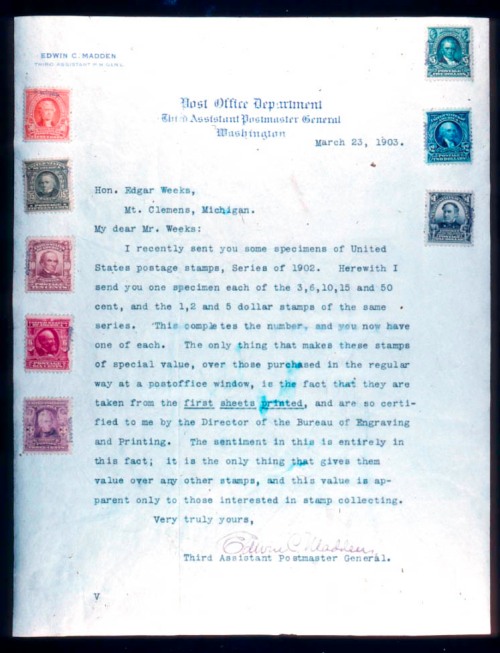
3c-$5.00 1902 Issue (302S, 305S, 307S, 309S-313S). Type E Specimen Overprints, applied to Official Post Office Letter indicating they came from the First Sheets Printed. Letter dated March 23, 1903 before many of the stamps were released to the public, Extremely Rare and possibly unique.
Rep. Weeks was not the only Michigander who obtained a complete set of the 1902 Series from the first sheets produced by the Bureau of Engraving & Printing. One J. William Hoban also received a set, as reflected in an October 26, 1903 letter sent by Madden, and illustrated below. In it, Madden explains that the original two-cent issue was deemed “not satisfactory” to the Department, and replaced with the 1903 version, a specimen of which is illustrated here:
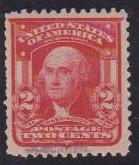
(319S-E), two-cent carmine, with Type E specimen overprint.
While I cannot say who Mr. Hoban was, the fact that it is addressed to the Post Office in Detroit suggests that he was, perhaps, the Postmaster of that city. In any event, Mr. Hoban’s name did not find its way onto the gift list for the 4c invert. The point, however, remains the same: A careful review of Mr. Madden’s correspondence might help catalog the number (and recipients) of specimen overprints created during his tenure, and speak to the then-routine practice of remembering friends and political allies in an era where the Post Office Department was among the most significant departments of the Federal Government, for purposes of using patronage to reward political stalwarts of the party in power.

A complete set of the 1902-03 Series is shown below.
I welcome my readers to share with me other insights into the tenure of Mr. Madden, especially as it concerns the distribution of specimen stamps.



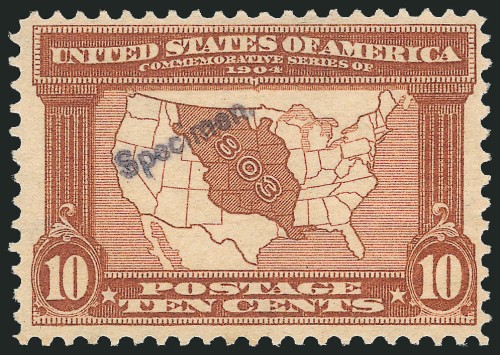
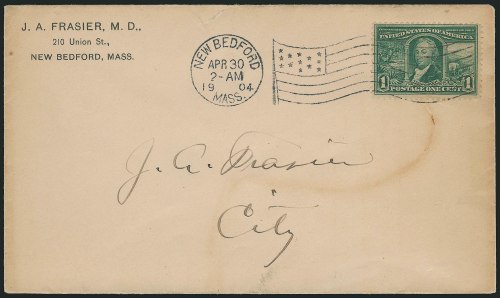
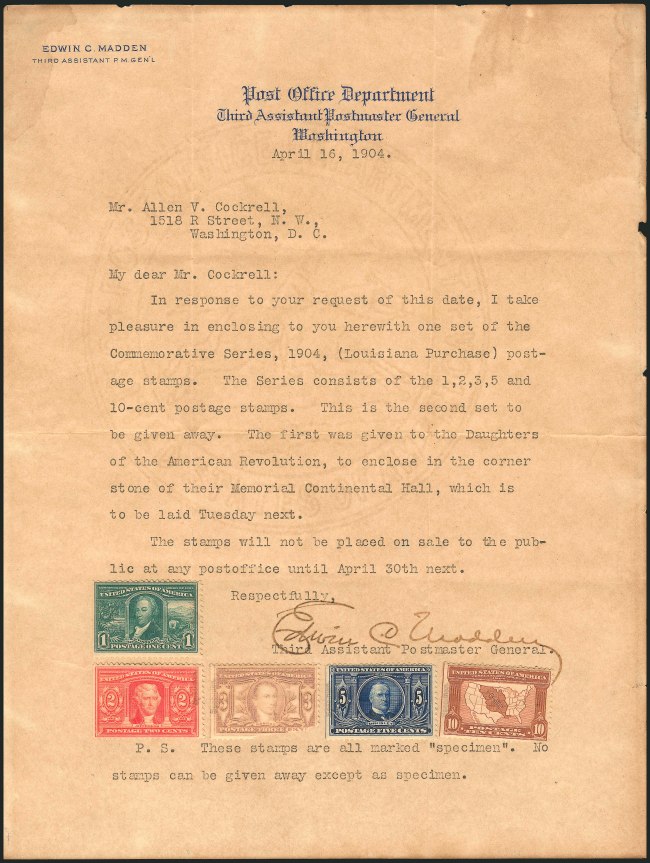
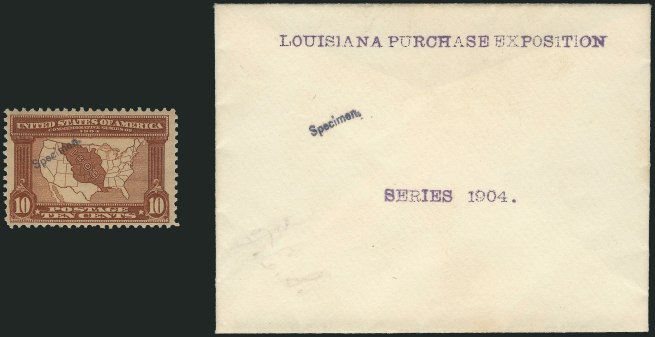







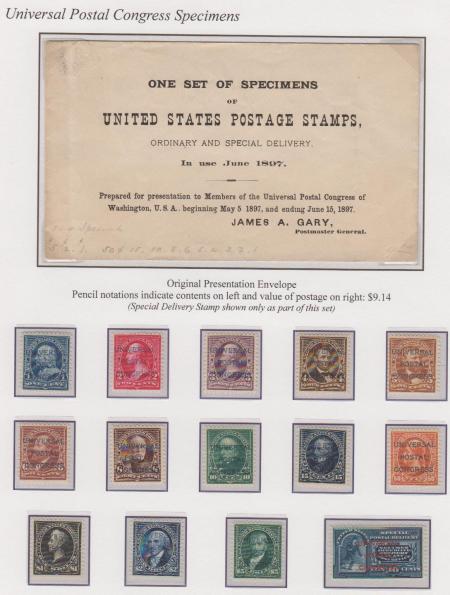
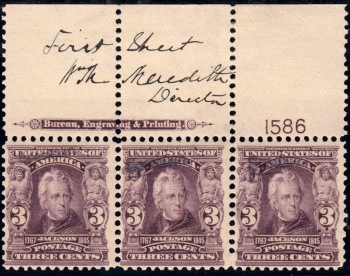
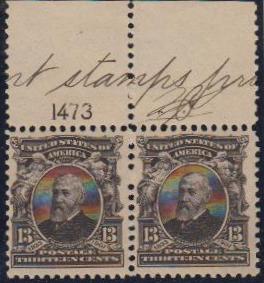





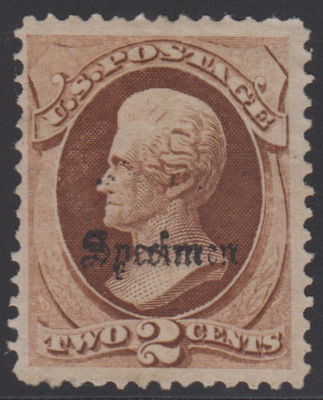



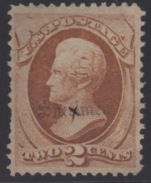

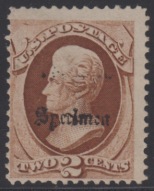
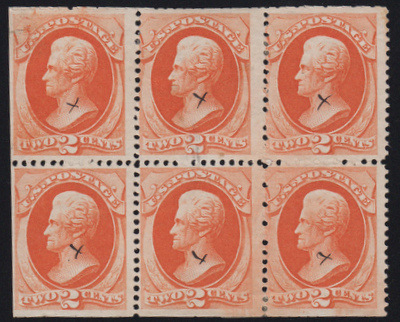

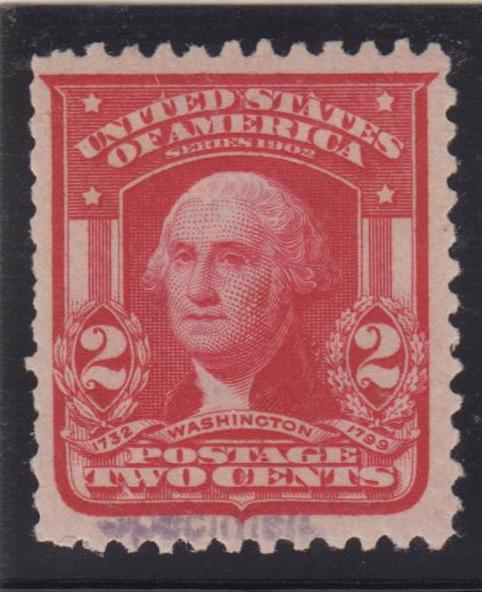
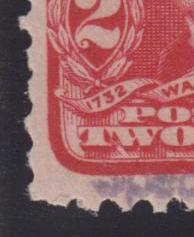









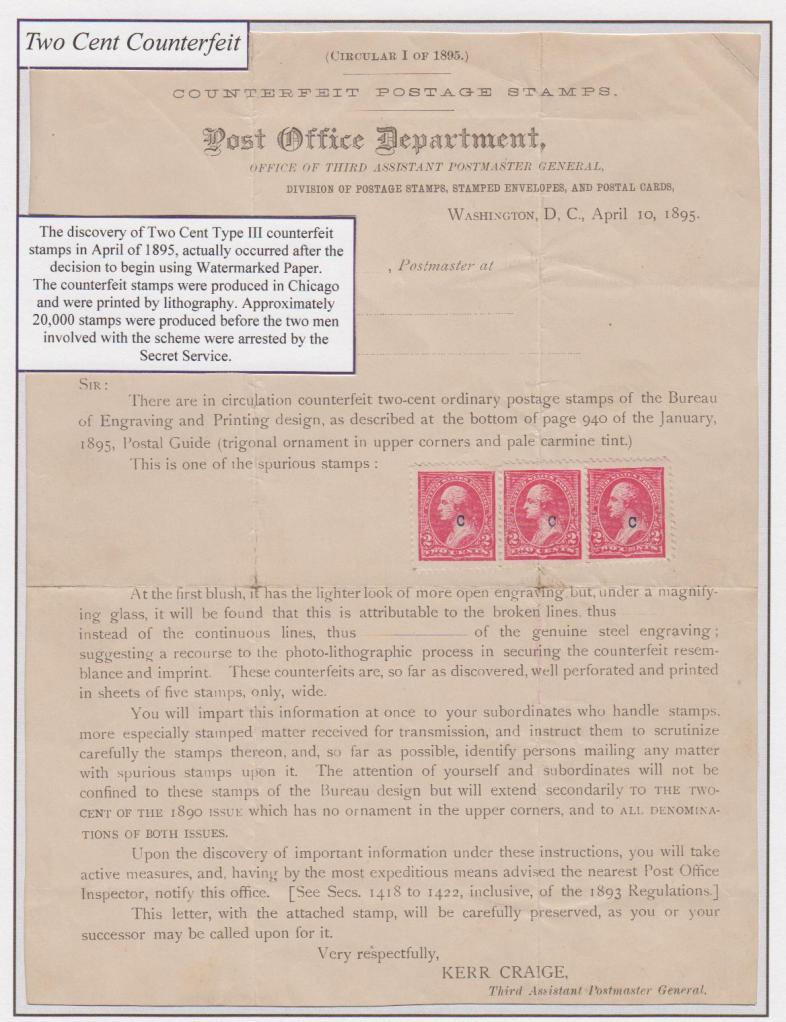



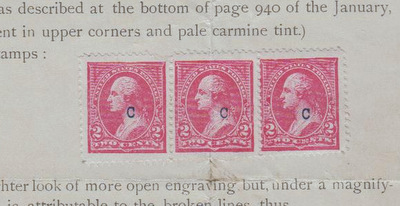


 As to regular issues, one could use any Re-Issue or Special Printing on a letter if you desired. Official stamps presented a different problem. To get around that problem the PO overprinted them with the word specimen so that if you tried to use it on mail the clerks could easily recognize what they were. They were done in this manner so that the Public could not use one on a letter
As to regular issues, one could use any Re-Issue or Special Printing on a letter if you desired. Official stamps presented a different problem. To get around that problem the PO overprinted them with the word specimen so that if you tried to use it on mail the clerks could easily recognize what they were. They were done in this manner so that the Public could not use one on a letter
 I own a $2 State where someone ( who obviously was not a true collector) attempted to remove the Specimen, thereby damaging one of the 32 sold.
I own a $2 State where someone ( who obviously was not a true collector) attempted to remove the Specimen, thereby damaging one of the 32 sold.